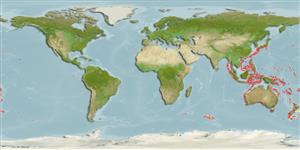Classification / Names
Common names from other countries
Main reference
Size / Weight / Age
Max length : 36.7 cm TL male/unsexed; (Ref. 54804)
Environment
Marine; bathydemersal; depth range 280 - 440 m (Ref. 54804)
Climate / Range
Tropical, preferred ?
Distribution
Short description
Dorsal
soft rays
(total): 256-300;
Anal
soft rays: 184 - 240;
Vertebrae: 151 - 155. Diagnosis: The snout is blunt; length of pectoral fins 49-55% of head length. Origin of dorsal fin above the end of pectoral fin. Vertebrae 151-155; trunk vertebrae 38-41. Lateral line pores to anus 25-28. Dorsal fin rays 256-300; anal fin rays 184-240 (Ref. 54804).
IUCN Red List Status (Ref. 115185)
Threat to humans
Harmless
Human uses
More information
Common namesSynonymsMetabolismPredatorsEcotoxicologyReproductionMaturitySpawningFecundityEggsEgg development
Age/SizeGrowthLength-weightLength-lengthLength-frequenciesMorphometricsMorphologyLarvaeLarval dynamicsRecruitmentAbundance
ReferencesAquacultureAquaculture profileStrainsGeneticsAllele frequenciesHeritabilityDiseasesProcessingMass conversion
Tools
Special reports
Download XML
Internet sources
Estimates of some properties based on models
Phylogenetic diversity index
PD50 = 0.7500 many relatives (e.g. carps) 0.5 - 2.0 few relatives (e.g. lungfishes)
Trophic Level
3.8 ±0.5 se; Based on size and trophs of closest relatives
Resilience
Medium, minimum population doubling time 1.4 - 4.4 years (Preliminary K or Fecundity.)
Vulnerability
Low to moderate vulnerability (32 of 100)
Price category
